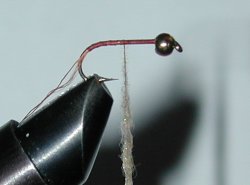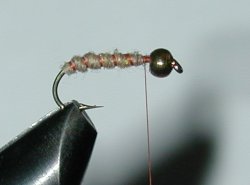Pelles Fiskes biggest inventions
Chapter 2- Gold-headed Européa-12 (GHE-12)
Text: Raven & The Graylinger
Photo: The Graylinger
 An
article we got published in the Swedish
fly-fishing magazine Flugfiske i Norden (translates to something
like; Flyfishing in Scandinavia) more then 15 years ago started like
this (here translated of course): "Européa 12 (or E-12 that is the
popular short name for the fly) is one of our most popular caddis
immitations, mainly famouse for attracting grayling. What is then
more natural than trying to use the fly's successful basic theme in
other caddis immitations - creating new dry flies as well as new wet
flies..."
An
article we got published in the Swedish
fly-fishing magazine Flugfiske i Norden (translates to something
like; Flyfishing in Scandinavia) more then 15 years ago started like
this (here translated of course): "Européa 12 (or E-12 that is the
popular short name for the fly) is one of our most popular caddis
immitations, mainly famouse for attracting grayling. What is then
more natural than trying to use the fly's successful basic theme in
other caddis immitations - creating new dry flies as well as new wet
flies..."
We experimented a lot back then, and the GHE-12 is one of the very few
creations that always holds a secured place in the fly-box - this
article is about that fly.
 The
above mentioned article described several version of the e-12 (most of
them now forgotten) - the specific part covering the GHE-12 translates
to:
The
above mentioned article described several version of the e-12 (most of
them now forgotten) - the specific part covering the GHE-12 translates
to:
"Lennart Bergqvist (sic: a very famous Swedish fly tier in the
eighties and nineties - famous in Sweden at least) has also introduced
the diving caddis fly, which imitates a caddis on its way down to the
bottom of the stream to lay their eggs. Lennart ties a variation with
the e-12 as a starting point, but he exchanges the hackle with a soft
partridge hackle, and ends up a with a Fly-Rite part. The fly is
fished up-stream, and a lead ball 75 centimeters up on the leader gets
it down close to the bottom. Gunnar Westrin (sic: a famous Swedish
fishing writer) once finished one of his lectures by mentioning that
he was going to try to tie, and fish, an e-12 with a gold head. We
don't know how he really imagined that fly's appearance in general,
but his idea formed the basis for a variant which is also based on,
and has borrowed elements from, Lennart Bergqvist's diving caddis. The
result is that you do not have to tangle with the lead ball on the
leader. The method thus becomes easier, although a non-weight fly with
the led ball on the leader moves differently in the water than if the
fly itself gives the weigth... That our own combination of Gunnar
Westrin's and Lennart Bergqvist's idea works perfectly we found out
during that summers mountain fishing trip - the new variation became
something of an all-round favorite as soon as the fish did not rise
for our floating Européa variants."
 A
lot of water has passed under the bridge since then, but the GHE-12 is
still as hot as allways. It has proven to deliver in more or less all
grayling waters it has been tried in, but maybe it feels most at home
at Stora Harrträsk - a grayling lake where fly trolling is the most
efficient method for catching fish, and here GHE-12 are one of the
dominant flies over the years.
A
lot of water has passed under the bridge since then, but the GHE-12 is
still as hot as allways. It has proven to deliver in more or less all
grayling waters it has been tried in, but maybe it feels most at home
at Stora Harrträsk - a grayling lake where fly trolling is the most
efficient method for catching fish, and here GHE-12 are one of the
dominant flies over the years.
Our first version was tied with a yellow thread, and that are nowadays
switched to brown, but apart from that our original pattern are still
the same - different variations simply have not proven to beat the
original. It seems that the pattern is more important than the size -
a classic wetfly hook of size 12 is what we most often use, but a size
10, 14 or 16 is also viable.
You can fish the fly on a czech nymph tackle, as a part of a classic
wet fly tackle or any other way you can think of (but not as dry of
course) and it will give you great chanses to catch your grayling of a
lifetime!
Tying the GHE-12
Material
To tie this fly will need the following materials:
- Hook. Choose a wet fly hook in size 12, for example Mustad 94840
- Thread. Since the will also act as a rib, we choose a thread of
brown color
- Dubbing. Spirit River has a nice dubbing called Fine & Dry, and
the coulur Hare's Ear excellent match to the body of the fly. Flyrite
in similar colors can also be used
- Wing. As on the regular e-12, a wing of the mallard breast feather
- Hackel. Partridge gives a soft and lively hackle
- Gold head. 3 mm is the correct size.
Description
Step 1 Begin by placing the gold head on the hook and fix the thread after the head. |
Step 2 Wrap the thread a little bit down on the hook eye. Make a loop of the thread fix in the back - this will later be acting as the rib. Then go forward with the thread and attatch the dubbing. |
|||
Step 3 Dub a body that ends a few millimeters before the gold head. Rib the body with the wire loop we created in step 2. |
Step 4 As wing, tie in a breast feather from mallard, sedge-style. |
|||
Step 5 A hackle of partridge is attached. Then wrap the thread so that the gold head will be quite fixed when you turn it backwards. Then make a few knots and cut the thread. |
Step 6 Add a drop of varnish on the thread and push back the gold head. Then fix the thread again, this time in front of the golden head. |
|||
|
||||
We apologize for the poor English...
/The Graylinger and Raven
